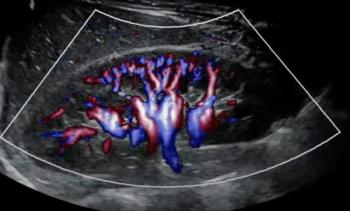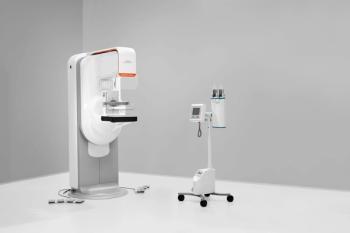
SonoSite products redefine ultrasound capabilities
From the first Monday of October to the end of the month, vendor SonoSite commercially launched five hand-carried ultrasound products. It was a month that could change the course of ultrasound.
From the first Monday of October to the end of the month, vendor SonoSite commercially launched five hand-carried ultrasound products. It was a month that could change the course of ultrasound.
The products, each focused on a different market niche and skill set, began to emerge Oct. 1, with M-Turbo, designed to support general applications that a radiologist or technologist might use at a patient's bedside. The second, S-FAST, marked
a new bent for the company, one focused on procedural medicine. S- FAST was designed specifically for emergency medicine. More significantly, it was the first in SonoSite's "S" series.
The company's two-pronged strategy-one toward radiology, the other toward specialties-began to take shape Oct. 8 with the release of S-NERVE, which provides anesthetists with visuals for doing nerve blocks. S-ICU for intensive care and S-CATH for interventional radiology and cardiology filled out the offerings.
The new hand-carried systems, M-Turbo and each of the S-Series devices, build into the 8.35-pound packages the same core computing engine incorporating Texas Instruments' DaVinci technology optimized for digital video, Windows Embedded CE 6.0 operating system for boot times under 15 seconds, and image-quality algorithms. SonoADAPT matches imaging parameters to exam type and patient size. SonoMB sharpens small structures and borders. SonoHD reduces artifacts, including speckle.
But it's the underlying nature of each device that's most significant. M-Turbo is really a radiological tool and the successor to SonoSite's MicroMaxx, with the image quality and capabilities, including Doppler, to make diagnoses, said Dave Willis, vice president of competitive strategy and innovation. The S-Series units are procedural tools.
Procedures such as nerve blocks often are done blindly. S-NERVE solves that without treading on radiology turf. Emergency medicine physicians have been using ultrasound themselves, not having the time to call for help from radiology. S-FAST just provides a more convenient and less expensive tool. S-ICU is designed to guide peripherally inserted central catheter and central line placements, dialysis access, and thoracentesis and paracentesis. All are simple procedures if the guidance is there. Even the S-CATH, which is oriented toward radiology, is a procedural tool, designed specifically for line placements and biopsies, Willis said.
Several of the miniature scanners were announced at medical meetings specific to their market niches, including those for the American College of Emergency Physicians (S-FAST), American Society of Anesthesiologists (S-NERVE), and American College of Chest Physicians (S-ICU). Not on the list was the RSNA meeting.
For reasons not publicly stated, SonoSite skipped the meeting, one of the world's most expensive for exhibitors, in lieu of the specialty meetings immediately preceding it. SonoSite's absence from the RSNA exhibit floor should not be interpreted as a shift away from its base, said Tom Dugan, senior vice president of global marketing and U.S. sales.
SonoSite has courted radiology since the company was spun off from ATL a decade ago to make way for the acquisition of ATL by Philips Medical Systems. Recently, GE Healthcare has introduced a family of laptop-sized ultrasound systems. Three months ago, Siemens Medical Solutions introduced a palm-sized ultrasound system. Other such introductions are expected.
Newsletter
Stay at the forefront of radiology with the Diagnostic Imaging newsletter, delivering the latest news, clinical insights, and imaging advancements for today’s radiologists.




























